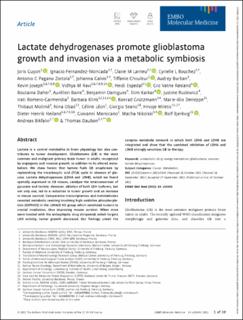| dc.contributor.author | Guyon, Joris | |
| dc.contributor.author | Fernandez-Moncada, Ignacio | |
| dc.contributor.author | Larrieu, Claire M | |
| dc.contributor.author | Bouchez, Cyrielle L | |
| dc.contributor.author | Pagano Zottola, Antonio C | |
| dc.contributor.author | Galvis, Johanna | |
| dc.contributor.author | Chouleur, Tiffanie | |
| dc.contributor.author | Burban, Audrey | |
| dc.contributor.author | Joseph, Kevin | |
| dc.contributor.author | Ravi, Vidhya M | |
| dc.contributor.author | Espedal, Heidi | |
| dc.contributor.author | Røsland, Gro Vatne | |
| dc.contributor.author | Daher, Boutaina | |
| dc.contributor.author | Barre, Aurélien | |
| dc.contributor.author | Dartigues, Benjamin | |
| dc.contributor.author | Karkar, Slim | |
| dc.contributor.author | Rudewicz, Justine | |
| dc.contributor.author | Romero-Garmendia, Irati | |
| dc.contributor.author | Klink, Barbara | |
| dc.contributor.author | Grützmann, Konrad | |
| dc.contributor.author | Derieppe, Marie-Alix | |
| dc.contributor.author | Molinié, Thibaut | |
| dc.contributor.author | Obad, Nina | |
| dc.contributor.author | Léon, Céline | |
| dc.contributor.author | Seano, Giorgio | |
| dc.contributor.author | Miletic, Hrvoje | |
| dc.contributor.author | Heiland, Dieter Henrik | |
| dc.contributor.author | Marsicano, Giovanni | |
| dc.contributor.author | Nikolski, Macha | |
| dc.contributor.author | Bjerkvig, Rolf | |
| dc.contributor.author | Bikfalvi, Andreas | |
| dc.contributor.author | Daubon, Thomas | |
| dc.date.accessioned | 2023-03-08T13:39:49Z | |
| dc.date.available | 2023-03-08T13:39:49Z | |
| dc.date.created | 2022-11-07T09:29:07Z | |
| dc.date.issued | 2022 | |
| dc.identifier.issn | 1757-4676 | |
| dc.identifier.uri | https://hdl.handle.net/11250/3057116 | |
| dc.description.abstract | Lactate is a central metabolite in brain physiology but also contributes to tumor development. Glioblastoma (GB) is the most common and malignant primary brain tumor in adults, recognized by angiogenic and invasive growth, in addition to its altered metabolism. We show herein that lactate fuels GB anaplerosis by replenishing the tricarboxylic acid (TCA) cycle in absence of glucose. Lactate dehydrogenases (LDHA and LDHB), which we found spatially expressed in GB tissues, catalyze the interconversion of pyruvate and lactate. However, ablation of both LDH isoforms, but not only one, led to a reduction in tumor growth and an increase in mouse survival. Comparative transcriptomics and metabolomics revealed metabolic rewiring involving high oxidative phosphorylation (OXPHOS) in the LDHA/B KO group which sensitized tumors to cranial irradiation, thus improving mouse survival. When mice were treated with the antiepileptic drug stiripentol, which targets LDH activity, tumor growth decreased. Our findings unveil the complex metabolic network in which both LDHA and LDHB are integrated and show that the combined inhibition of LDHA and LDHB strongly sensitizes GB to therapy. | en_US |
| dc.language.iso | eng | en_US |
| dc.publisher | Embo Press | en_US |
| dc.rights | Navngivelse 4.0 Internasjonal | * |
| dc.rights.uri | http://creativecommons.org/licenses/by/4.0/deed.no | * |
| dc.title | Lactate dehydrogenases promote glioblastoma growth and invasion via a metabolic symbiosis | en_US |
| dc.type | Journal article | en_US |
| dc.type | Peer reviewed | en_US |
| dc.description.version | publishedVersion | en_US |
| dc.rights.holder | Copyright 2022 The Author(s) | en_US |
| dc.source.articlenumber | e15343 | en_US |
| cristin.ispublished | true | |
| cristin.fulltext | original | |
| cristin.qualitycode | 2 | |
| dc.identifier.doi | 10.15252/emmm.202115343 | |
| dc.identifier.cristin | 2069727 | |
| dc.source.journal | EMBO Molecular Medicine | en_US |
| dc.identifier.citation | EMBO Molecular Medicine. 2022, 14, e15343. | en_US |
| dc.source.volume | 14 | en_US |

